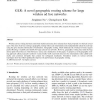Free Online Productivity Tools
i2Speak
i2Symbol
i2OCR
iTex2Img
iWeb2Print
iWeb2Shot
i2Type
iPdf2Split
iPdf2Merge
i2Bopomofo
i2Arabic
i2Style
i2Image
i2PDF
iLatex2Rtf
Sci2ools
CN
2006
2006
GLR: A novel geographic routing scheme for large wireless ad hoc networks
Wireless ad hoc routing has been extensively studied and many clever schemes have been proposed over the last several years. One class of ad hoc routing is geographic routing where each intermediate node independently selects the next hop using the given location information of destination. Geographic routing, which eliminates the overhead of route request packet flooding, is scalable and suitable for large scale ad hoc networks. However, geographic routing may select the long detour paths when there are voids between a source and a destination. In this paper, we propose a novel geographic routing approach called geographic landmark routing (GLR). GLR recursively discovers the intermediate nodes called landmarks and constructs sub-paths that connect the subsequent landmarks. Simulation results on various network topologies show that GLR significantly improves the performance of geographic routing.
Ad Hoc | CN 2006 | Geographic Routing | Routing |
| Added | 11 Dec 2010 |
| Updated | 11 Dec 2010 |
| Type | Journal |
| Year | 2006 |
| Where | CN |
| Authors | Jongkeun Na, Chong-kwon Kim |
Comments (0)

